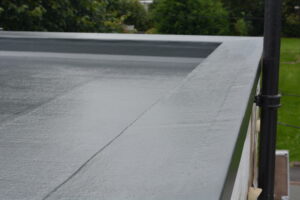Contents
- 1 How many layers of fibreglass, 1
- 1.1 Additionally, a fibreglass roof made with a single layer of chopped strand matting is also low maintenance, as it is resistant to moisture, weathering, and rot. This means that once installed, you can expect a fibreglass roof to last for many years with minimal upkeep. Furthermore, fibreglass roofing is also fire-resistant, making it a safe option for a variety of applications.
- 1.2 How many layers of fibreglass?: Bad effects of a fibreglass roof with more than 2 layers
How many layers of fibreglass, 1
How many layers of fibreglass? do I need for a flat roof?
Fibreglass roofs made with a single layer of CSM are ideal for flat or low-slope roofs, as they offer enough stiffness and stability to prevent the roof from sagging or warping over time. Additionally, a single layer of CSM is also more cost-effective than using multiple layers, as it requires less material and labour.

How many layers of fibreglass? One layer is generally required
A popular question about flat roofs is how many layers of fibreglass do I need for a flat roof? Fibreglass roofing is a popular choice for those looking for a durable and long-lasting roofing solution. One of the key advantages of fibreglass roofing is that it only requires a single layer of chopped strand matting (CSM) to provide optimal performance.
Chopped strand matting is a type of fibreglass reinforcement that is made up of randomly oriented short fibres, which are held together by a binder. It is a versatile and cost-effective option for roofing because it provides excellent strength and stability, even when used in a single layer.
Fibreglass roofs made with a single layer of CSM are ideal for flat or low-slope roofs, as they offer enough stiffness and stability to prevent the roof from sagging or warping over time. Additionally, a single layer of CSM is also more cost-effective than using multiple layers, as it requires less material and labor.
How many layers of fibreglass? Another advantage of using a single layer of CSM for fibreglass roofing is that it is relatively easy to install. With the right tools and materials, most DIY enthusiasts can install a fibreglass roof with a single layer of CSM with minimal difficulty.
How many layers of fibreglass? conclusion, a fibreglass roof made with a single layer of chopped strand matting is a durable, cost-effective, and easy-to-install solution for flat or low-slope roofs. Whether you are a DIY enthusiast or a professional roofer, this type of roofing system provides excellent performance and value for money.
Additionally, a fibreglass roof made with a single layer of chopped strand matting is also low maintenance, as it is resistant to moisture, weathering, and rot. This means that once installed, you can expect a fibreglass roof to last for many years with minimal upkeep. Furthermore, fibreglass roofing is also fire-resistant, making it a safe option for a variety of applications.
In short, if you are looking for a roofing solution that provides excellent performance, ease of installation, and affordability, a fibreglass roof made with a single layer of chopped strand matting is definitely worth considering. Whether you are building a new home, repairing an existing roof, or updating your commercial property, fibreglass roofing provides a versatile and reliable solution that will meet your needs and exceed your expectations.
How many layers of fibreglass?: Bad effects of a fibreglass roof with more than 2 layers
Using more than two layers of chopped strand matting (CSM) in a fibreglass roof can have several negative effects. Here are a few of the main drawbacks:
- Increased weight: Additional layers of CSM will add weight to the roof, which can put extra stress on the roof structure and support beams. This can be especially problematic for flat or low-slope roofs, where there is less structural support to begin with.
- Increased cost: More layers of CSM means more material and labor, which can make the cost of a fibreglass roof significantly more expensive. This can make fibreglass roofing less attractive as a cost-effective option.
- Reduced flexibility: The more layers of CSM you add to a fibreglass roof, the stiffer and less flexible it becomes. This can make it more difficult to install, as the roof may be more prone to cracking or breaking if it is not handled carefully.
- Reduced lifespan: Although fibreglass roofing is known for its durability and long lifespan, adding too many layers of CSM can actually reduce its lifespan. The extra weight and stiffness can put additional stress on the roof and cause it to deteriorate more quickly over time.
In conclusion, How many layers of fibreglass? while multiple layers of CSM can provide additional strength and stability, using more than two layers can have negative effects on the weight, cost, flexibility, and lifespan of a fibreglass roof. For most applications, a single or double layer of CSM is sufficient for providing optimal performance.
Q: How many layers of fibreglass? should I apply for my project? A: The number of layers of fiberglass needed depends on the specific requirements of your project. In general, a single layer may be sufficient for lightweight applications, while heavier-duty or load-bearing projects may require multiple layers. Refer to the product guidelines and project specifications for recommendations.
Q: Is there a standard thickness for fiberglass layers in construction projects? A: There isn’t a one-size-fits-all standard thickness for fiberglass layers, as it varies based on the application and project requirements. The thickness is determined by factors such as structural needs, strength, and the intended use of the fiberglass. Follow project specifications and industry standards for guidance.
Q: Can I add more layers of fiberglass for extra strength? A: Yes, you can add more layers of fiberglass to enhance strength and durability. However, it’s essential to follow the manufacturer’s recommendations and guidelines to ensure proper curing and adhesion between layers. Adding too many layers without proper consideration may affect the overall performance.
Q: How do I determine the right number of fiberglass layers for my repair project? A: Assess the extent of damage and the load-bearing requirements of your repair. For small repairs, a single layer may suffice, while larger or structural repairs may necessitate additional layers. Consult with a professional or refer to product guidelines for a tailored recommendation.
Q: Can I use a single layer of fiberglass for cosmetic repairs? A: Yes, a single layer of fiberglass can be suitable for cosmetic repairs or surface enhancements where structural reinforcement is not the primary concern. Always consider the specific needs of your project and follow recommended application techniques.
Q: What is the role of each fiberglass layer in laminations? A: Each fiberglass layer in laminations contributes to the overall strength, rigidity, and durability of the composite. The layers work together to distribute stress and load, providing structural integrity. The specific design and number of layers depend on the intended application and performance requirements.
These answers are general guidelines, and it’s crucial to refer to the product instructions, project specifications, and industry standards for accurate information related to the use of fiberglass layers in your specific application.
If you enjoyed this article about How many layers of fibreglass? read more articles GRP NO1 GUIDE








